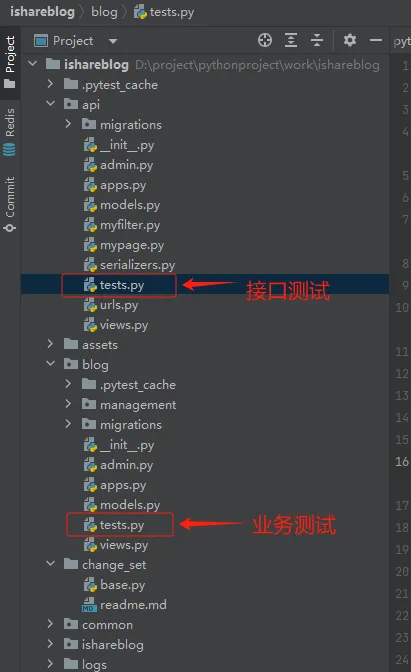
在Django项目中集成Pytest进行单元测试可以提高测试的灵活性和效率,相比于Django自带的测试框架,Pytest提供了更为丰富和强大的测试功能。本文通过一个实际项目ishareblog介绍django集成pytest进行自动化单元测试实战。
一、引入pytest相关的包
pip install pytest
pip install pytest-django
pip install pytest-html
其中pytest-django插件,它提供了Django和Pytest之间的桥梁,pytest-html 是一个 pytest 的插件,用于生成详细的 HTML 测试报告。这个插件能够将 pytest 运行的结果转化为一个直观、易于阅读的 HTML 格式报告,这对于分享测试结果、审查测试覆盖率以及归档测试历史非常有帮助。
二、配置pytest
1、将django的配置区分测试环境、开发环境和生产环境
因为测试环境、开发环境和生产环境的环境配置参数不一样,一个好的实践是将开发、测试和生产环境通过配置区分开,django的配置主要集中在项目的settings.py文件,这里通过settings.py的配置文件将开发、测试、生产区分开,不同的环境调用不通的配置文件。

因为大部分的配置参数都是一样的,在这里我将公共的配置参数都抽到了base.py,环境配置中有差异的部分分别放到各自的配置文件中,如开发环境用的是mysql,测试环境用sqlite3,就可以将不同的配置给区分开。 测试环境是settings_test.py,这里除了数据库的配置不一样,其他都沿用基础的公共配置。settings_test.py配置如下:
from .base import *
# SECURITY WARNING: don't run with debug turned on in production!
DEBUG = True
ALLOWED_HOSTS = []
DATABASES = {
'default': {
'ENGINE': 'django.db.backends.sqlite3',
'NAME': os.path.join(BASE_DIR, 'test_db.sqlite3'),
}
}
2、配置pytest
在Django项目根目录下,创建或编辑pytest.ini文件,来配置Pytest。

pytest.ini代码如下:
[pytest]
DJANGO_SETTINGS_MODULE = ishareblog.settings_test
python_files = tests.py test_*.py *_tests.py
DJANGO_SETTINGS_MODULE = ishareblog.settings_test 指定了pytest用到的环境配置 python_files = tests.py test_*.py *_tests.py 指定了pytest将测试以test开头的py文件中的测试用例。
三、编写测试用例
接下来,可以在tests.py或test_*.py文件中编写你的测试用例。由于pytest-django插件的存在,你可以像平常一样使用Django的测试机制,同时也能享受Pytest带来的便利。以下以我的ishareblog博客代码通过业务测试和接口测试来编写测试用例。

1、业务测试
我的isharebog业务相对简单,主要是测试验证业务模型模块的增删改查是否符合预期。 业务测试tests.py示例代码如下:
import pytest
from django.test import TestCase
from blog.models import BlogCategory
@pytest.mark.django_db
class TestBlogCategory(TestCase):
def setUp(self):
self.blogcategory = BlogCategory.objects.create(id=1,title="Test Category", href='/category/1')
def test_BogCategoryModel(self):
blog_category = BlogCategory.objects.get(id=self.blogcategory.id)
self.assertEqual(blog_category.title, "Test Category")
self.assertEqual(blog_category.href, '/category/1')
@pytest.mark.django_db
def test_blog_category_create():
blogcategory = BlogCategory.objects.create(id=1,title="Test Category", href='/category/1')
category_count = BlogCategory.objects.count()
assert category_count > 0, "Blog category was not created category_count=0."
assert blogcategory.id > 0, "Blog category was not created."
assert blogcategory.title == "Test Category", "Blog category title is wrong."
assert blogcategory.href == "/category/1", "Blog category href is wrong."
@pytest.mark.django_db
def test_blog_category_query():
category_count = len(BlogCategory.objects.all())
assert category_count >= 0, "Blog category query error."
if __name__ == '__main__':
pytest.main(["-s", "-v", "-p", "no:warnings", "--tb=short", "--html=report.html", "blog/tests.py"])
业务测试举了通过测试类和测试方法写的测试用例,分别对博客目录进行添加和查询编写了测试用例。
2、接口测试
接口是暴露给前端程序调用的,接口测试主要是测试接口正不正常,接口值是不是符合预期。
import requests
import pytest
host = "http://localhost:8000"
class TestApi:
def test_getcategory_list(self):
url = f'{host}/api/category/'
response = requests.get(url)
assert response.status_code == 200, f'Expected status code 200 but got {response.status_code}'
assert response.json() != None, f'Expected to get json response but got {response.text}'
print(response.json())
def test_getpost_list(self):
url = f'{host}/api/post/list'
response = requests.get(url)
assert response.status_code == 200, f'Expected status code 200 but got {response.status_code}'
assert response.json() != None, f'Expected to get json response but got {response.text}'
if __name__ == '__main__':
pytest.main(["-s", "-v", "-p", "no:warnings", "--tb=short", "--html=report.html", "api/tests.py"])
接口测试部分,对获取目录的API接口和文章列表的API接口编写了测试用例。
四、进行测试
最后可以分别在blog目录和api目录下运行test.py 分别进行业务和接口的单元测试。
注意在进行测试之前需要执行 python manage.py makemigrations --settings=ishareblog.settings_test 初始化环境。
在进行api接口测试之前需要将django的应用服务启动 python manage.py runserver 8000 --settings=ishareblog.settings_test 启动的时候也带上测试环境的配置。
可以通过pytest --html=report.html 自动执行所有的单元测试,并生成可读的html的测试报告。

pytest生成的report.html测试报告

以上通过一个ishareblog的实际项目介绍django集成pytest进行自动化单元测试实战。 ishareblog的所有代码包括pytest的配置见 https://gitee.com/xiejava/ishareblog
博客地址:http://xiejava.ishareread.com/

关注:微信公众号,一起学习成长!